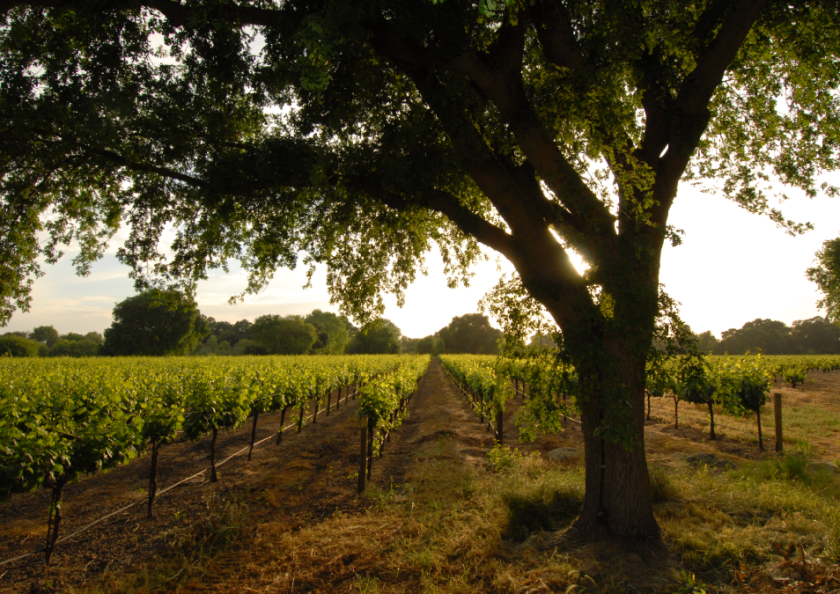
The official end of the rainfall year shows a total of 10.2 inches of rain for 2013-14 – the driest season in the last 12 years and only slightly ahead of the 1976-77 drought. Fortunately, the last significant rain occurred with perfect timing and in a heavy event that mitigated the very dry soil conditions for local vineyards. Enough rain fell just before budbreak to provide for good growth and well-formed clusters that set a good crop.
After the dry winter, slightly above average daytime temperatures (but below average cool nights) and lots of wind, irrigation generally started earlier and more steady than usual. The start of budbeak was not dramatically ahead of average and by actual vine development or Growing Degree Days measure. It appears vines are only 7 to 10 days ahead of long term average.
__________________________________________________________________________________
Paul Verdegaal is the UCCE farm advisor for San Joaquin County, specializing in winegrapes and almonds. Read more about Paul HERE.
__________________________________________________________________________________
The end of rain season arrived at 61% of average for total rainfall, compared to 85% last year. This is the driest year since 1976, but still second compared to the 1976-77 drought. The problem is with acres of grapes, there are more people and environmental diversions required. Future water supplies will be a concern, unless water storage and delivery systems are upgraded.
The last rains in late February and early March helped alleviate the stress of the current drought effects, but most vineyards have very dry soil profiles below two feet, even though vines in general look good with respect to shoot growth.
 Vines affected by the current drought and thesevere cold spell in early December are still recovering from those effects, but are looking better. The current hot weather and ongoing ET demand may cause vine stress more quickly and more severely than would normally be expected, so adequate or higher levels of irrigation may be needed.
Vines affected by the current drought and thesevere cold spell in early December are still recovering from those effects, but are looking better. The current hot weather and ongoing ET demand may cause vine stress more quickly and more severely than would normally be expected, so adequate or higher levels of irrigation may be needed.
After two huge crops, vines may take a rest this year. But I think the drought conditions may result in average to below average crop as clusters and berries may be smaller than average due to dry soils; even with above average irrigation and ideal spring weather.
Powdery mildew pressure seems a little less severe this year than in 2013, but still a problem needing to be monitored closely. Whatever the material of choice; a good powdery mildew program includes: some sulfur, rotation of materials between years, and complete coverage – all three are important. Also, shorten intervals between treatments as disease pressure increases.
Insects and mite pressure appears to be average, light, or at least scattered. Some drought related mite problems can be expected, but this considering three dry years in a row, vines are generally holding up well to most control programs. Fortunately, there are a good number of registered materials to choose from and to mix up in a long-term rotation strategy.
__________________________________________________________________________________
Lodi Rainfall Seasonal: 2002-2014 (Inches)
| Year 2002 2003 2004 2005 2006 2007 2008 2009 2010 2011 2012 2013 2014 Average |
Total 16.3 15.2 15.3 23.1 23.4 12.1 13.7 15.1 19.2 26.3 12.4 15.5 10.2 17.8 |
% Avg 92 86 87 131 132 68 78 85 109 149 70 89 61 – |
Oct/Nov/Dec 9.7 8.7 9.2 10.4 7.1 4.6 4.5 4.0 6.1 12.1 3.0 11.0 2.2 7.5 |
Jan 2.0 0.6 0.6 3.2 5.4 0.3 7.3 1.9 4.5 1.4 2.9 1.2 0.1 2.6 |
Feb 1.0 4.7 0.9 3.3 1.1 4.3 1.8 5.3 3.6 4.1 1.3 0.3 4.7 2.6 |
Mar 2.5 1.1 0.6 3.5 5.2 0.6 0.1 1.9 1.8 5.8 3.3 2.1 1.9 2.4 |
Apr 0.2 0.1 3.6 1.4 3.8 2.3 0.0 0.7 2.9 0.2 1.9 0.5 1.4 1.5 |
May 0.9 0.1 0.4 1.3 0.8 – 0.0 1.3 0.3 1.4 – 0.1 0.02 0.7 |
Jun 0.0 0.0 0.0 0.0 0.0 0.0 0.0 0.0 0.0 1.3 0.0 0.2 0.0 0.1 |
__________________________________________________________________________________
Continue to be on the lookout for Vine Mealybug (VMB) as it spreads. There are options for control, and Movento (spirotetramat) returned last year as a possible choice of several materials. VMB is now becoming active enough to begin looking for. Pay close attention toareas of bird roosting and watch for high traffic spots of ants that may lead into vines.
Light Brown Apple Moth (LBAM) is spreading in the Manteca and Tracy areas and may begin to be seen near several of the landscape nursery operations around the county – be on the lookout. It is controllable, as is the more traditional pest of Omnivorous Leaf Roller (OLR). LBAM does, unfortunately, require quarantine and more paperwork. Stay in touch with the County Ag Commissioner office and with your winery or grape buyer to keep up with compliance areas in movement of harvested crops. For more information click HERE.
The ongoing “new” problem is the identification, recognition and understanding of a new Grape Leaf Roll associated Virus (GLRaV), named Grape Red Blotch associated Virus (GRBaV). As in the past, order from reputable nurseries, purchase Certified Virus tested vines, and/or know the history of any variety selections chosen. GRBaV seems to be similar to the well-known GLRaV, but it manifests itself more by delaying and limiting full sugar accumulation in some sites. The presence of GRBaV has become apparent in many locations across many varieties and regions that debate and investigation continues on how it might be spread. To see more, click HERE or HERE.
What looks to be an average crop and increased wine sales should be of help to maintain a balance in the market demand. Lodi remains a region that provides the resources and conditions to grow quality grapes for a wide range of wine styles of quality and value. Have a good harvest in 2014.

